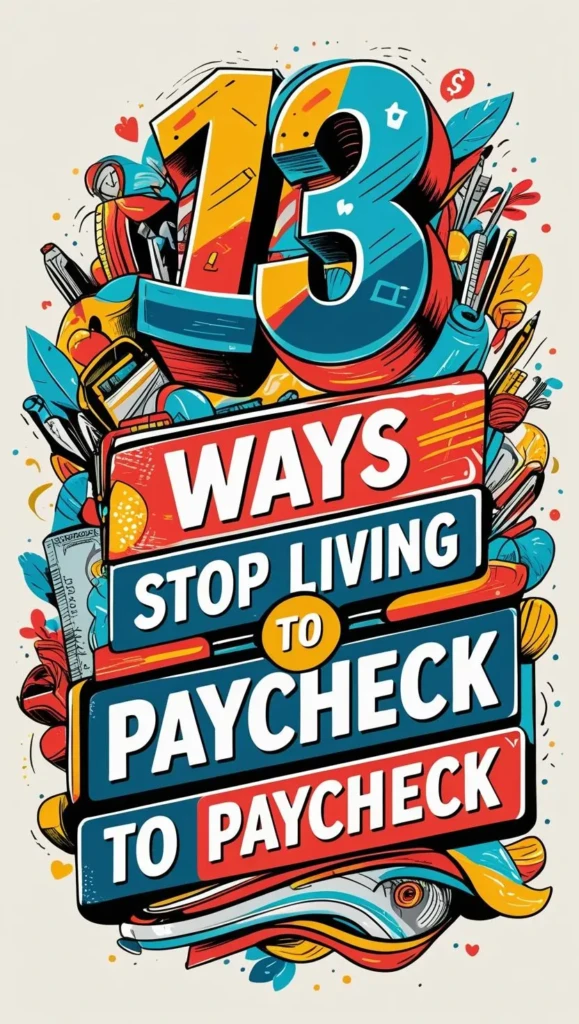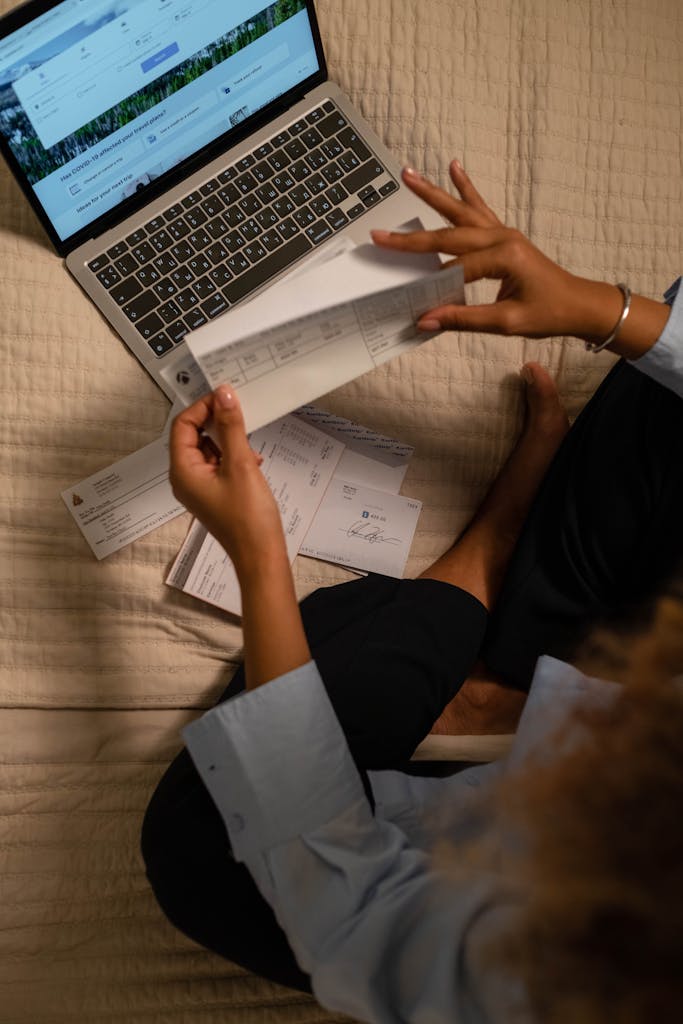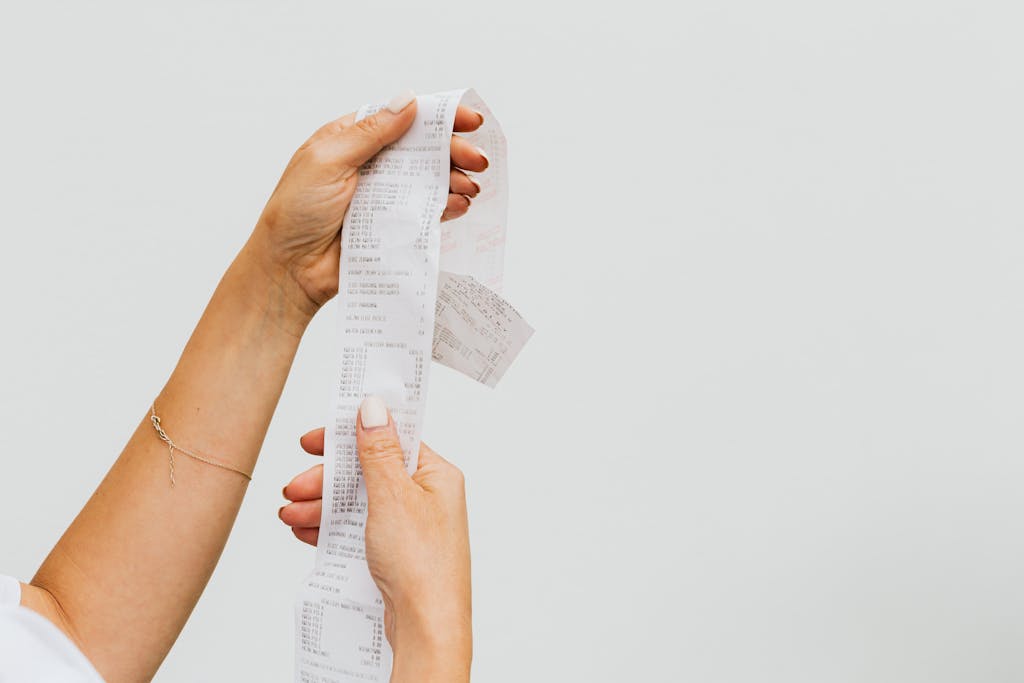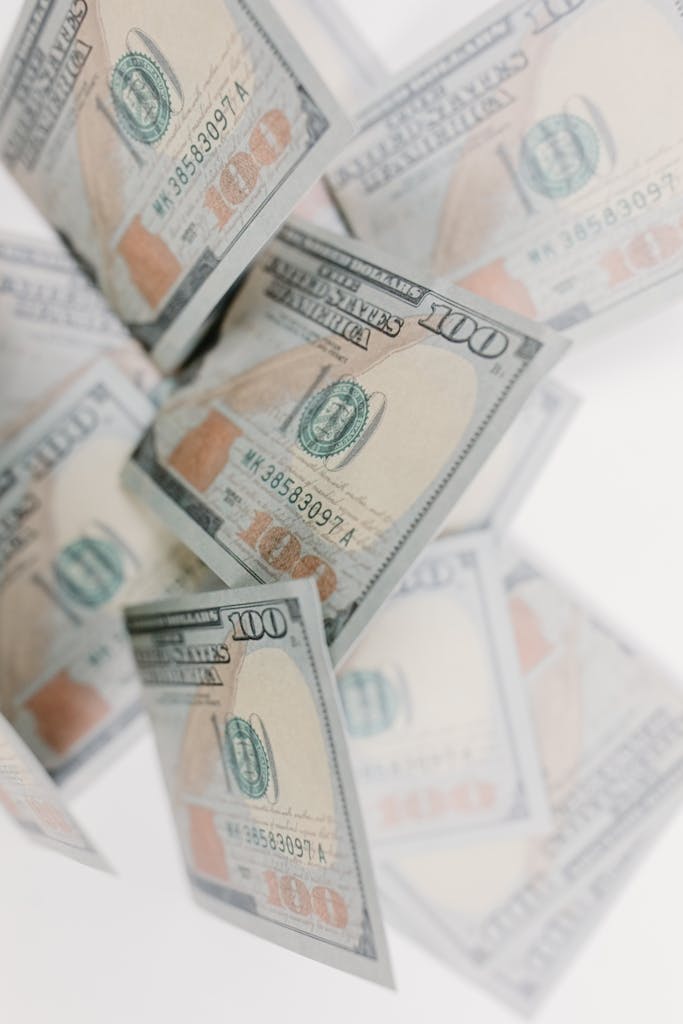
You know that sinking feeling when your bank account hits zero three days before payday? I’ve been there, staring at my phone calculator at 2 AM, trying to figure out how $2,847 disappeared so quickly. Breaking the paycheck-to-paycheck cycle isn’t about earning more money—it’s about controlling where your current income actually goes. After implementing these thirteen strategies, I went from having $23 in savings to building real financial breathing room, and you can too.
Key Takeaways

- Track spending for two weeks and create a realistic monthly budget that includes necessities, wants, and allocated fun money
- Prioritize your four walls first: food, utilities, shelter, and transportation before addressing any other expenses
- Cancel unused subscriptions and negotiate better rates on recurring services to eliminate unnecessary monthly costs
- Build a $1,000 emergency fund by starting small with $25-50 per paycheck in a separate savings account
- Use the debt snowball method to eliminate high-interest debt by paying off smallest balances first
Create a Realistic Monthly Budget
Why does creating a budget feel like trying to solve a math problem while blindfolded? Because most people approach it backwards, making unrealistic cuts that’ll never stick.
Here’s what actually works: Start by tracking your spending for two weeks. Don’t change anything yet, just write down every dollar that leaves your account. I discovered I was spending $127 monthly on coffee runs – ouch.
Next, analyze your spending habits without judgment. You’re gathering intel, not punishing yourself. Then create categories: necessities, wants, and savings. Give every dollar a job before the month starts.
The secret? Build in fun money. I budget $80 for random purchases because denying yourself completely leads to budget explosions. You’re taking control, not becoming a financial monk.
Use accounting software to track your income and expenses automatically, making it easier to stick to your budget and see exactly where your money goes each month.
Prioritize Your Four Walls First

When your budget feels tighter than skinny jeans after Thanksgiving dinner, you need a game plan that protects what matters most. Your four walls aren’t just living expenses—they’re your financial fortress. Before you even think about that streaming service or coffee shop habit, secure these essentials first.
| Four Wall | Monthly Cost | Priority Level |
|---|---|---|
| Food | $400-600 | Critical |
| Utilities | $150-250 | Critical |
| Shelter | $800-1200 | Critical |
| Transportation | $200-400 | Critical |
This isn’t about being boring—it’s about being bulletproof. When making ends meet feels impossible, covering these four categories first gives you unshakeable ground to stand on. Everything else can wait until your foundation is rock-solid and your paycheck-to-paycheck cycle finally breaks. Once you’ve mastered distinguishing needs from wants, you’ll develop the financial clarity that successful women use to build lasting wealth.
Cut Unnecessary Subscriptions and Services
Since most of us collect subscriptions like they’re going out of style, it’s time for some brutal honesty about what’s actually draining your bank account each month. When you’re living paycheck to paycheck, that $15 Netflix subscription combined with Hulu, Disney+, and three gym memberships you forgot about becomes a $200 monthly monster.
Here’s your power move: scrutinize every single recurring charge on your bank statements. Cancel what you don’t use religiously, negotiate better rates on your cell phone and internet plans, and consolidate streaming services into shared accounts. I found $180 in forgotten subscriptions last month – that’s real money you can redirect toward breaking the paycheck-to-paycheck cycle. Smart spending means controlling your subscriptions before they control you, helping you save money consistently. Consider using a digital brain tool to track all your subscriptions and recurring expenses in one organized place, making it easier to spot patterns and eliminate unnecessary costs.
Build a $1,000 Emergency Fund
Building your first $1,000 emergency fund might feel overwhelming, but you’ll start with just $25 or $50 from each paycheck and watch it grow faster than you’d expect. The key is opening a separate savings account that’s not connected to your debit card, because let’s be honest, if it’s too easy to access, you’ll convince yourself that pizza definitely counts as an emergency.
Once you’ve got this fund tucked away safely, you’ll need to treat it like it’s surrounded by an invisible force field, only breaking through for real emergencies like car repairs or medical bills, not because your favorite store is having a sale. If you need to accelerate your savings, consider starting a freelance writing business or offering virtual assistant services, which can help you earn extra income with minimal upfront investment.
Start Small, Build Gradually
The beauty of emergency funds isn’t that they need to be massive right away – it’s that they just need to exist. When you start small with just $25 per paycheck, you’re not trying to become Warren Buffett overnight. You’re building a habit that’ll save your financial sanity later.
That first $100 feels impossible, but once it’s there, you’ll feel unstoppable. Set up automatic transfers from your paycheck straight to a separate emergency fund account – trust me, you won’t even miss money you never see.
After hitting your $1,000 goal, gradually increase your monthly contributions. Each milestone deserves celebration because you’re breaking free from that suffocating paycheck-to-paycheck cycle, one small victory at a time.
Separate Emergency Fund Account
After you’ve started building that savings habit, it’s time to give your emergency fund a proper home – and I mean completely separate from your checking account where you pay for groceries and Netflix. You need a dedicated savings account that’s harder to access when you’re tempted to spend. Open one at a different bank if you have to, whatever keeps you from casually dipping into it for non-emergencies.
Your goal is $1,000 as fast as possible – skip the fancy coffee, sell stuff you don’t need, work extra hours. This emergency fund becomes your financial bodyguard, protecting you from relying on credit cards when life inevitably throws curveballs. No more stretching each paycheck to breaking point when unexpected expenses hit.
Avoid Touching Fund
Once you’ve got that $1,000 sitting pretty in your emergency fund, you’ll face your biggest test – actually leaving it alone. That money will whisper sweet temptations every time you see something you want, but resist like your financial future depends on it.
| Emergency | Not Emergency |
|---|---|
| Medical bills | New shoes on sale |
| Car repairs | Dinner with friends |
| Job loss | Vacation fund |
| Home repairs | Latest gadget |
Your emergency fund isn’t a shopping spree account – it’s your financial cushion against life’s curveballs. Without a financial safety net, you’ll slide right back into paycheck-to-paycheck living. Keep this money sacred, separate, and untouchable unless genuine emergencies strike.
Eliminate High-Interest Debt Using the Snowball Method

You’ll start by listing all your debts from smallest balance to largest, ignoring interest rates completely for now. Once you’ve knocked out that first small debt, you’ll take that payment amount and roll it into the next smallest debt, creating momentum that builds like a snowball rolling downhill.
This approach might seem backward since you’re not tackling the highest interest rates first, but trust me, those quick wins will keep you motivated when credit card statements feel more overwhelming than your morning coffee addiction. As you free up money from eliminated debt payments, consider channeling those funds into a home-based business that can generate additional income streams to further accelerate your debt payoff journey.
List Debts Smallest First
While most financial experts debate whether to tackle high-interest debt first or smallest balances, I’ve found that the debt snowball method works wonders for people who need psychological wins to stay motivated. You’ll start by listing every single debt from smallest to largest balance – ignore interest rates completely for now.
| Debt Type | Balance | Minimum Payment |
|---|---|---|
| Credit Card A | $347 | $25 |
| Medical Bill | $1,200 | $50 |
| Car Loan | $8,500 | $285 |
Trust me, seeing that smallest debt disappear first creates incredible momentum. When you pay off debt number one, you’ll roll that payment into the next smallest balance. This snowball effect builds confidence and keeps your money working harder as you eliminate each debt completely.
Roll Payments Forward
Here’s where the magic really happens – you take that $25 monthly payment from Credit Card A and immediately add it to your next smallest debt. This is the heart of the debt snowball method, and it’s absolutely game-changing.
Let’s say your second smallest debt has a $40 minimum payment. Now you’re attacking it with $65 every month instead of just scraping by with minimums.
The momentum builds fast because you’re not starting from scratch with each debt. When you pay off the smallest debt, you’ve already proven you can handle that payment amount. Rolling it forward feels natural, almost effortless.
Before you know it, you’re throwing $100, then $200 at debts that used to intimidate you. That’s real financial power in action.
Negotiate Your Salary or Find Higher-Paying Work
Sometimes the most obvious solution is staring right at you, but it’s also the scariest one to tackle. When you’re stuck in the paycheck-to-paycheck cycle, boosting your income can break the chain faster than cutting expenses alone.
Breaking the paycheck-to-paycheck cycle requires courage to pursue the scariest but most obvious solution: earning more money.
Here’s your power move playbook:
- Research your worth – Use salary comparison sites to discover you’re probably underpaid by $5,000-15,000 annually
- Document your wins – List every accomplishment, project completion, and problem you’ve solved this year
- Practice your pitch – Rehearse asking for that raise until it feels natural, not desperate
You’ve got options beyond your current job too. Start a side hustle delivering food or freelancing your skills. Better yet, hunt for a better-paying job while you’re still employed—you’ll negotiate from strength, not desperation.
Consider leveraging your existing skills to create online courses that can generate passive income while you work your regular job.
Develop a Side Hustle for Extra Income
You don’t need to become the next tech billionaire to escape the paycheck-to-paycheck trap, you just need to leverage what you’re already good at. Starting with your existing skills keeps things simple and cheap, whether that’s tutoring kids in math, walking dogs in your neighborhood, or selling those crafts you make while binge-watching Netflix.
The beauty of side hustles is that you can start small with just a few hours a week, then gradually scale up as you figure out what actually makes money and what’s just a time-sucking hobby in disguise. Consider exploring growing markets like virtual assistant services, which allow you to work with clients globally while maintaining a flexible schedule that fits around your main job.
Choose Your Skills
One of the smartest moves I ever made was turning my random skills into cold, hard cash through side hustles. You’ve got abilities hiding in plain sight that could earn extra income starting today.
I started by listing everything I could do, from writing grocery lists to fixing neighbors’ computers. Then I matched those skills to actual money-making opportunities. Here’s how to dominate this process:
- Inventory your talents ruthlessly – Write down every skill, hobby, and random thing people ask you for help with
- Research what pays – Check Fiverr, Upwork, and local Facebook groups to see what services command real money
- Start with one skill – Pick your strongest ability and launch immediately rather than overthinking
Your skills are your secret weapons for financial freedom.
Start Small Scale
Now it’s time to actually launch that side hustle, and I’m telling you from experience that starting small beats waiting for the perfect moment every single time. Don’t quit your day job tomorrow – that’s a recipe for disaster. Instead, dedicate 5-10 hours weekly to your chosen side hustle.
I started with just three hours of freelance writing on weekends, earning $200 my first month. That wasn’t life-changing money, but it proved the concept worked. Whether you’re driving for rideshare services, tutoring kids online, or walking dogs, start with manageable hours. Use every dollar you earn from these side hustles to pay off your debt aggressively. This approach helps you break the cycle without risking your financial stability.
Maximize Earning Potential
Building on that foundation, it’s time to scale up and truly maximize what you’re earning from your side hustle. You’ve got the basics down, so now let’s start planning your path to serious extra income. The key is leveraging what you already know while expanding strategically.
Here’s how to make your personal finance situation truly powerful:
- Double down on your highest-paying skills – If you’re earning $25/hour tutoring but only $12/hour doing surveys, guess which one deserves more time?
- Create multiple income streams from one skill – Teaching piano? Offer lessons, sell sheet music, and create online courses.
- Reinvest profits back into growth – Use earnings to buy better equipment, take courses, or advertise your services.
Practice Mindful Spending Habits

Mindful spending sounds fancy, but it’s really just paying attention to where your money goes instead of wondering why your bank account looks like a sad emoji every month. You’ll stop taking those mysterious $12.99 monthly charges for apps you forgot existed, and suddenly you can spend less on nonsense while making ends meet.
Start tracking every dollar for one week – yes, even that $4 coffee. You’ll discover you’re bleeding money on takeout, impulse Amazon purchases, and subscriptions you never use. Create a realistic budget that prioritizes essentials first, then debt payments and savings. Switch to cash or debit cards to avoid credit card temptation.
Meal planning saves hundreds monthly on food waste and spontaneous restaurant visits. Instead of expensive takeout, prepare high protein breakfasts like Greek yogurt parfaits or overnight chia pudding that cost a fraction of restaurant meals while keeping you satisfied longer.
Use the Envelope System for Variable Expenses
While budgeting apps are great, sometimes you need something more tangible than numbers on a screen – especially when you’re the type who “accidentally” spends $80 at Target for just shampoo. The envelope system gives you physical control over your variable expenses, making overspending nearly impossible.
Here’s how to take command of your spending:
- Calculate your monthly variable expenses – groceries, gas, entertainment, and dining out
- Set aside cash for each category at the beginning of every month
- Label separate envelopes and distribute the predetermined amounts
When the grocery envelope has $300, that’s your limit. No credit cards, no exceptions. This forces you to pay attention to every purchase and make conscious choices. You’ll quickly discover which expenses actually matter versus impulse buys that drain your paycheck.
Once you’ve mastered controlling your variable expenses, consider creating a comprehensive business plan that includes detailed financial projections to help strengthen your long-term financial goals.
Automate Your Savings and Bill Payments
Fighting the urge to “just this once” dip into your savings account becomes infinitely easier when you can’t easily access that money in the first place. When you automate your savings, you’re essentially paying yourself first before you even see that money hit your checking account. Set up automatic transfers for a fixed amount—even $50 per paycheck adds up to $1,300 yearly.
Your bill payments deserve the same treatment. Automate recurring expenses like rent, utilities, and subscriptions to avoid those annoying $35 late fees that demolish your budget faster than you can say “oops.” Use budgeting apps to schedule everything at once, then review monthly to guarantee amounts still align with your goals. You’ll control spending habits while building financial momentum.
Take automation even further by using app automation tools to connect your banking apps with budgeting software, automatically categorizing transactions and updating your financial dashboard without manual data entry.
Live Below Your Means
Because most of us have champagne tastes on a beer budget, learning to live below your means feels like asking someone to voluntarily downsize from a mansion to a studio apartment. But here’s the thing – living below your means isn’t about deprivation, it’s about taking control of your financial destiny.
Start Building wealth by mastering these power moves:
- Cut your housing costs to 25% of income – Yes, that cramped apartment beats living paycheck to paycheck
- Drive a reliable used car – Your ego might bruise, but your bank account will thank you
- Cook at home 80% of the time – Those $15 takeout meals add up to $450 monthly
This living strategy creates breathing room in your budget, transforming you from financial victim to financial victor.
Save Up for Large Purchases Instead of Financing

When that shiny new couch starts whispering sweet nothings about “0% financing for 24 months,” you’re staring at one of the biggest traps keeping you stuck in paycheck-to-paycheck hell. Those monthly payments look manageable until you’re juggling five different financing plans simultaneously.
Save up for large purchases instead. Create a dedicated savings account for that $2,000 refrigerator or $15,000 car. When you pay cash, you’re not just avoiding interest charges—you’re seizing control of your financial destiny.
I learned this lesson after financing a $1,800 washer that ended up costing $2,400 with interest. Now I save $200 monthly for future appliances. You’ll stop living paycheck to paycheck faster when debt isn’t draining your income every month.
Define Your Financial Goals and Remember Your Why
Three years ago, I was throwing money at random financial goals like spaghetti at a wall, hoping something would stick. Spoiler alert: it didn’t work.
Now I define specific financial goals and recollect my “why” behind each one, which completely transformed my relationship with money and credit decisions.
- Write down your exact goal amount – Need $15,000 for a house down payment? Write it down and post it where you’ll see it daily.
- Define your emotional “why” – Are you saving to give your kids stability? That emotional connection fuels commitment when temptation strikes.
- Prioritize ruthlessly – Rank your financial goals by importance, then attack the top one with laser focus.
This approach works for any financial decisions you’ll face.
Conclusion
Breaking free from the paycheck-to-paycheck trap isn’t rocket science, but it does require commitment and patience. You’ll stumble along the way—I certainly did when I blew $200 on takeout in one week. Start with your budget, tackle those four walls, and build that $1,000 emergency fund. Recall, you’re not depriving yourself, you’re investing in your future self. Trust me, financial peace is worth every sacrifice you’ll make.




Leave a Reply